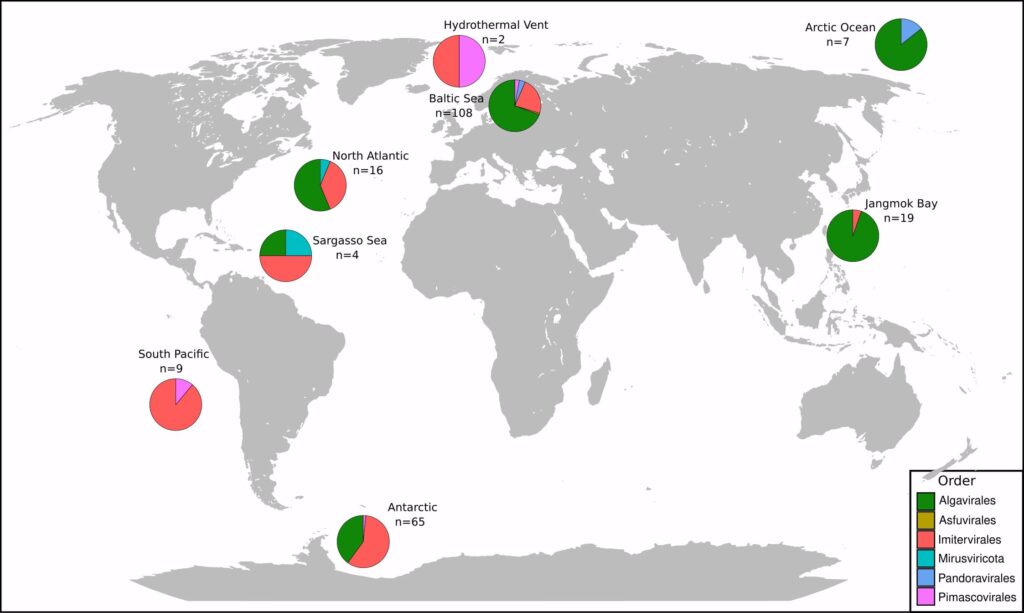By Diana Udel, University of Miami News
Giant viruses play a role in the survival of single-celled marine organisms called protists. These include algae, amoeba and flagellates, that form the base of ocean food webs. And since these protists form an important part of the food chain, these large DNA viruses are often responsible for various public health hazards, including harmful algal blooms.
A new study from scientists at the University of Miami’s Rosenstiel School of Marine, Atmospheric and Earth Science may help unravel the many types of viruses present in our waterways and oceans. This knowledge could help local leaders better prepare for when a harmful algal bloom may be impacting their coastline or if any other viruses are present in local bays, rivers or lakes.

Using high-performance computing methods, researchers identified 230 novel giant viruses in publicly available marine metagenomic datasets and characterized their functions.
Published in the journal Nature npj Viruses, their findings include the discovery of new giant virus genomes previously unknown in literature. Within these genomes, 530 new functional proteins were characterized, including nine proteins involved in photosynthesis. This indicates that these viruses may be able to manipulate their host and the photosynthesis process during infection.
“By better understanding the diversity and role of giant viruses in the ocean and how they interact with algae and other ocean microbes, we can predict and possibly manage harmful algal blooms, which are human health hazards in Florida as well as all over the world,” said Mohammad Moniruzzaman, a co-author of the study and an assistant professor in the Department of Marine Biology and Ecology. “Giant viruses are often the main cause of death for many phytoplankton, which serve as the base of the food web supporting ocean ecosystems and food sources. The novel functions found in giant viruses could have biotechnological potential, as some of these functions might represent novel enzymes.”
Until recently, giant viruses were largely undetected by scientific methods due to limitations in bioinformatic pipelines. The researchers created an innovative tool called BEREN (Bioinformatic tool for Eukaryotic virus Recovery from Environmental metageNomes), designed to identify giant virus genomes within extensive public DNA sequencing datasets.

“We discovered that giant viruses possess genes involved in cellular functions such as carbon metabolism and photosynthesis — traditionally found only in cellular organisms,” said Benjamin Minch, the lead author of the study and a doctoral student in the Department of Marine Biology and Ecology at the Rosenstiel School. “This suggests that giant viruses play an outsized role in manipulating their host’s metabolism during infection and influencing marine biogeochemistry.”
The authors used the University of Miami’s Pegasus supercomputer at the Frost Institute for Data Science and Computing (IDSC) to process and assemble large metagenomes — often exceeding a gigabase per library — enabling the reconstruction of hundreds of microbial community libraries.
“This study allowed us to create a framework to improve existing tools for detecting novel viruses that could aid in our ability to monitor pollution and pathogens in our waterways.” Minch added.
The research team downloaded DNA sequencing data from nine large global ocean sampling projects spanning from pole to pole. Using BEREN, they recovered giant virus genomes from the data. The genomes were then annotated using publicly available gene function databases to characterize the functions encoded by these viruses. These genomes were compared to all currently available giant virus representatives to identify novel functions.
The BEREN program used to facilitate this research fills a gap in the research field by providing an easy-to-use, one-stop tool for identifying and classifying giant viruses in sequencing datasets. BEREN is available for anyone to use and can be download at: https://gitlab.com/benminch1/BEREN.
The study titled, “Expansion of the genomic and functional diversity of global ocean giant viruses,” was published on April 21 in the journal Nature npj Viruses. The authors are Benjamin Minch and Mohammad Moniruzzaman from the University of Miami Rosenstiel School of Marine, Atmospheric, and Earth Science.
This piece was originally published at https://news.miami.edu/rosenstiel/stories/2025/06/scientists-discover-230-new-giant-viruses-that-shape-ocean-life-and-health.html. Banner photo: A giant virus infection of the unicellular algae Florenciella. The giant viruses can be seen bursting out of the Florenciella cell with their hexagon-shaped capsids that enclose their genetic material. (Grieg Steward, Ph.D./University of Hawai’i at Manoa).
Sign up for The Invading Sea newsletter by visiting here. To support The Invading Sea, click here to make a donation. If you are interested in submitting an opinion piece to The Invading Sea, email Editor Nathan Crabbe at nc*****@*au.edu.



